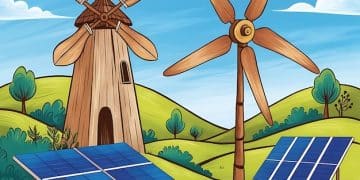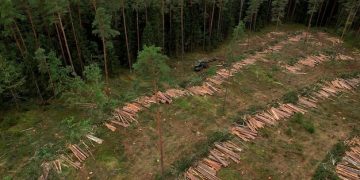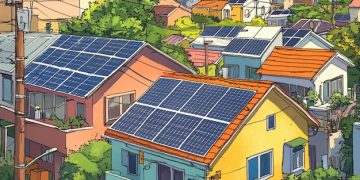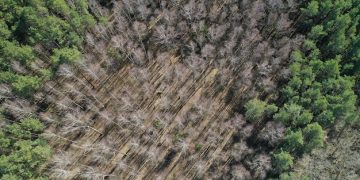Deforestation & Carbon Sequestration: Are US Forests Declining?
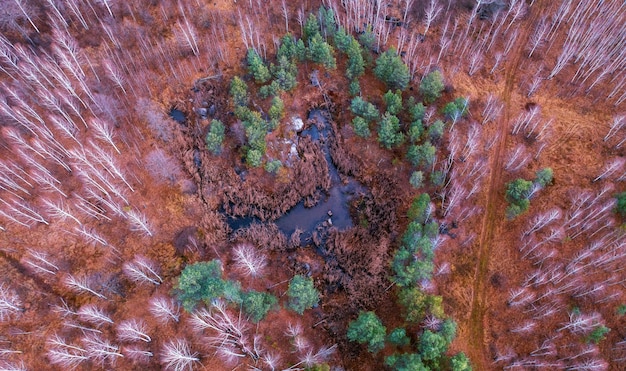
Deforestation and carbon sequestration are intrinsically linked, particularly in the US, where forests play a crucial role in carbon storage; however, increasing deforestation raises concerns about whether these forests are maintaining their capacity to offset carbon emissions effectively.
The delicate balance between deforestation and carbon sequestration is facing unprecedented challenges in the United States. Are our forests, vital carbon sinks, losing ground in this critical environmental equation?
Understanding Deforestation in the US
Deforestation in the United States, though not as rampant as in some other parts of the world, remains a significant concern. It is essential to understand the scale, causes, and consequences of forest loss across the nation.
Scope of Deforestation
Although the US has a long history of forest management, deforestation continues to occur due to various factors. Tracking the extent of these losses provides a valuable snapshot of the evolving landscape. Deforestation is a concerning issue in the United States, driven by urbanization, agriculture, and resource extraction.
Primary Causes of Deforestation
Several factors contribute to deforestation in the US, each exerting different pressures on forest ecosystems. Understanding these causes helps in developing targeted conservation and management strategies. Major causes of deforestation in the US include urban sprawl, agricultural expansion, logging, and natural disasters such as wildfires.
- Urban Expansion: Growing cities and suburban areas require land clearing for housing, infrastructure, and commercial development, leading to forest loss.
- Agricultural Conversion: Forests are often cleared to create farmland for crops and pastures for livestock, especially in regions with fertile soil.
- Logging Practices: Unsustainable logging practices can result in deforestation if forests are not managed responsibly or if clear-cutting is employed without adequate replanting.
- Natural Disasters: Events like wildfires, hurricanes, and pest infestations can cause widespread forest damage, which sometimes leads to permanent deforestation if the areas are not restored.
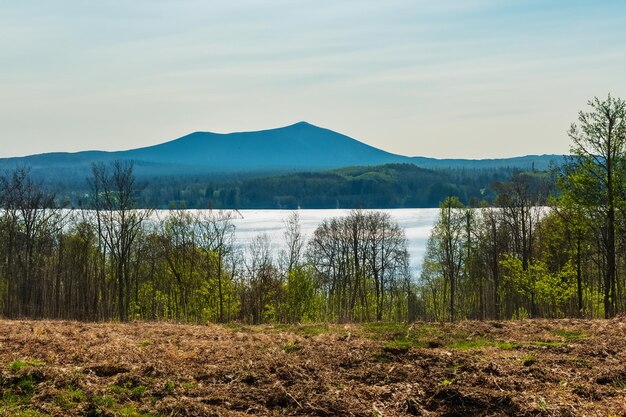
Ultimately, addressing deforestation requires a multifaceted approach that includes policy changes, sustainable land management practices, and community engagement.
The Role of US Forests in Carbon Sequestration
US forests play a vital role in mitigating climate change through carbon sequestration, the process by which trees and other vegetation absorb carbon dioxide from the atmosphere. Recognizing and enhancing this capacity is crucial for meeting national carbon reduction goals.
Carbon Storage Capacity
The capability of US forests to store carbon is immense, but it varies depending on forest type, age, and region. Maximizing this potential requires understanding and managing forests effectively. The carbon storage capacity of US forests is substantial, with older forests generally holding more carbon due to accumulated biomass.
Forests act as significant carbon sinks, absorbing CO2 during photosynthesis and storing it in biomass such as tree trunks, branches, roots, and soil.
Factors Affecting Carbon Sequestration
Several factors influence the rate and amount of carbon sequestration in forests. These factors include forest management practices, climate conditions, and the health of the forest ecosystem. Forest management practices significantly impact carbon sequestration, with sustainable methods enhancing forests’ ability to absorb and store carbon.
- Forest Management: Sustainable forestry practices, such as selective logging and prescribed burns, can enhance carbon sequestration while maintaining forest health.
- Climate Change: Changes in temperature and precipitation patterns can affect tree growth and survival, influencing carbon sequestration rates.
- Forest Health: Healthy forests are better able to sequester carbon, so managing pests, diseases, and invasive species is essential for maintaining their carbon storage capacity.
Enhancing the carbon sequestration potential of US forests requires a holistic approach that integrates sustainable management practices, climate resilience strategies, and proactive measures to protect forest health.

The Impact of Deforestation on Carbon Sequestration
Deforestation significantly reduces the capacity of US forests to sequester carbon, exacerbating climate change. The consequences of forest loss extend beyond immediate carbon releases, affecting long-term environmental stability.
Reduced Carbon Uptake
When forests are cleared, the carbon they have stored is released into the atmosphere, reducing the overall carbon uptake. This reversal exacerbates greenhouse gas emissions. Deforestation leads to a significant reduction in carbon uptake, as fewer trees are available to absorb CO2, resulting in a net release of carbon into the atmosphere.
The immediate impact of deforestation is the release of stored carbon, contributing to greenhouse gas emissions.
Long-Term Effects on Ecosystems
Beyond carbon emissions, deforestation has broad and lasting effects on ecosystems, including loss of biodiversity and changes in water cycles. These effects undermine the long-term health and resilience of forests. Deforestation disrupts ecosystems, leading to habitat loss, reduced biodiversity, and alterations in local climate patterns, such as increased temperatures and decreased rainfall.
- Biodiversity Reduction: Forests are home to a vast array of plant and animal species, and deforestation leads to habitat loss and species extinction.
- Water Cycle Disruption: Forests play a crucial role in regulating water cycles, and deforestation can lead to soil erosion, increased runoff, and decreased water quality.
- Soil Degradation: The removal of tree cover exposes soil to erosion and nutrient loss, reducing its fertility and productivity.
Mitigating the impact of deforestation requires a comprehensive approach that includes reforestation efforts, sustainable land management practices, and policies to protect existing forests.
Current Trends in US Forest Cover
Tracking current trends in US forest cover provides insights into the effectiveness of conservation efforts and the ongoing pressures on forest ecosystems. Analyzing these trends is essential for informing future policy and management strategies.
Recent Losses and Gains
While some regions of the US have experienced forest loss, others have seen gains due to reforestation and afforestation efforts. Examining these regional differences is crucial for understanding the overall picture. Recent trends show a mix of forest losses and gains, with some regions experiencing net deforestation due to urbanization and agriculture, while others see reforestation successes.
Despite conservation efforts, the US continues to experience forest loss due to urbanization, agriculture, and natural disasters.
Regional Variations
Forest cover changes vary significantly across different regions of the US due to diverse land use practices and environmental conditions. Understanding these variations is essential for tailoring conservation strategies to specific needs. Regional variations in forest cover depend on factors like land use policies, economic activities, and climate conditions, with some areas showing more resilience than others.
For example, the southeastern US has experienced significant afforestation due to timber plantations, while the western states face challenges from wildfires and drought.
Effective forest management requires a nuanced understanding of these dynamics, integrating scientific research, community participation, and adaptive strategies.
Strategies for Sustainable Forest Management
Sustainable forest management practices are essential for balancing the need for forest resources with the long-term health and carbon sequestration potential of US forests. Implementing these strategies can help ensure a sustainable future. Sustainable forest management focuses on maintaining the ecological, economic, and social benefits of forests for current and future generations, balancing resource extraction with ecosystem health.
Reforestation and Afforestation
Reforestation (replanting trees in deforested areas) and afforestation (planting trees in areas that were not previously forested) are vital strategies for restoring forest cover and enhancing carbon sequestration. These initiatives help reverse the impacts of deforestation and expand carbon sinks. Reforestation and afforestation are critical strategies for increasing carbon sequestration by re-establishing forests in areas previously deforested or creating new forests in non-forested lands.
Improved Logging Practices
Adopting sustainable logging practices, such as selective cutting and reduced-impact logging, can minimize the damage to forest ecosystems while still allowing for timber harvesting. These practices help maintain forest health and carbon storage. Improved logging practices, such as selective cutting and reduced-impact logging, minimize disturbance to forest ecosystems, preserving carbon stocks and biodiversity.
- Selective Cutting: Harvesting only mature trees while leaving younger trees to grow, maintaining continuous forest cover.
- Reduced-Impact Logging: Using specialized equipment and techniques to minimize soil compaction and damage to non-target trees.
- Forest Certification: Supporting certification programs that promote sustainable forest management practices and responsible sourcing of timber products.
Promoting these techniques requires collaboration among landowners, policymakers, and forestry professionals to ensure widespread adoption and effective implementation.
The Future of US Forests and Carbon Sequestration
The future of US forests and their role in carbon sequestration depends on proactive and adaptive management strategies. Addressing the challenges posed by climate change, deforestation, and other threats is crucial for ensuring the long-term health and resilience of these vital ecosystems.
Policy and Conservation
Strengthening policies and conservation efforts is essential for protecting US forests and enhancing their carbon sequestration potential. These measures can help mitigate the impacts of deforestation and promote sustainable forest management. Policy and conservation efforts are critical for protecting US forests and enhancing their role in carbon sequestration through initiatives like protected areas, incentives for sustainable management, and regulations against deforestation.
Government policies play a crucial role in promoting sustainable forest management and protecting forests from deforestation.
Climate Change Adaptation
Developing strategies to help forests adapt to climate change is vital for maintaining their health and carbon sequestration capacity. These strategies include promoting drought-resistant tree species and managing forests to reduce wildfire risk. Climate change adaptation strategies are essential for helping forests withstand the impacts of changing temperatures, precipitation patterns, and increased disturbances like wildfires and pest outbreaks.
For example, promoting the planting of drought-resistant tree species can help forests survive and thrive in drier conditions.
Innovation and collaboration are essential for navigating the complexities of forest management in a changing world, ensuring these vital ecosystems continue to thrive and provide their essential services.
| Key Point | Brief Description |
|---|---|
| 🌳 Deforestation Causes | Urbanization, agriculture, and logging drive forest loss. |
| 💨 Carbon Sequestration | Forests absorb and store CO2, reducing greenhouse gases. |
| 📉 Impact of Forest Loss | Reduced carbon uptake exacerbates climate change. |
| 🌱 Sustainable Practices | Reforestation and improved logging enhance carbon sequestration. |
Frequently Asked Questions
▼
Deforestation in the US is primarily driven by urbanization, agricultural expansion, logging, and natural disasters like wildfires, each contributing to the loss of forest cover.
▼
US forests play a vital role in carbon sequestration by absorbing carbon dioxide from the atmosphere during photosynthesis and storing it in their biomass and soil.
▼
Deforestation reduces carbon uptake, releasing stored carbon into the atmosphere, which diminishes the forest’s capacity to act as a carbon sink and worsens climate change.
▼
Strategies include reforestation, afforestation, and implementing improved logging practices that minimize ecosystem disturbance while allowing for timber harvesting.
▼
Strengthening policies, promoting conservation efforts, and incentivizing sustainable forest management are essential steps to protect US forests and enhance their carbon sequestration potential.
Conclusion
In conclusion, the relationship between deforestation and carbon sequestration in US forests is a critical issue that demands immediate attention. By understanding the causes and impacts of deforestation, implementing sustainable management strategies, and strengthening policies, we can work to ensure the long-term health and carbon sequestration capacity of these vital ecosystems, contributing to a more sustainable future.
